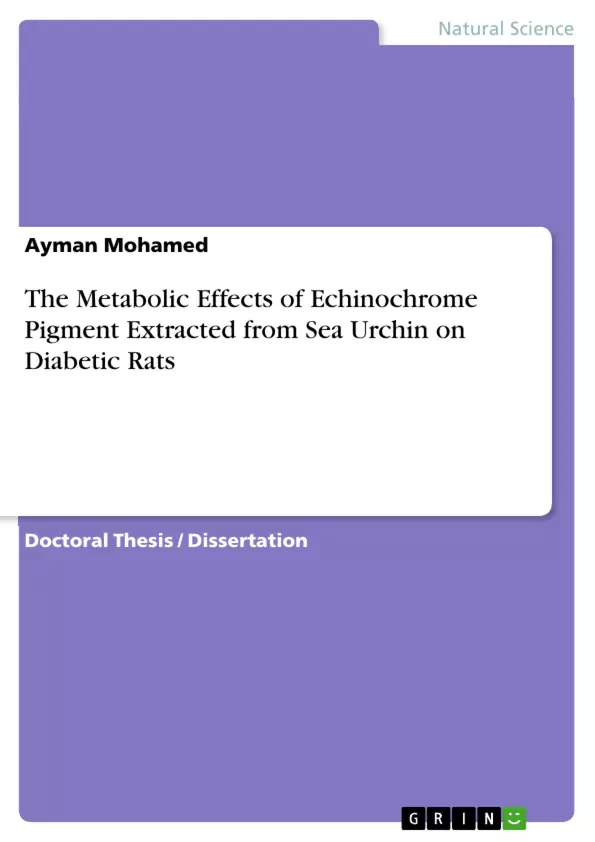
The Metabolic Effects of Echinochrome Pigment Extracted from Sea Urchin on Diabetic Rats
Doktorarbeit / Dissertation, 2018
243 Seiten, Note: 4
Leseprobe
Table of Contents
- I. Introduction
- Aim of work
- II. Materials and methods
- II.1. Chemicals and reagents
- II.2. Sea urchin Collection
- II.3. Echinochrome (Ech) extraction
- II.4. Experimental animals
- II.5. Ethical Consideration
- II.6. Induction of type 1 diabetes mellitus (T1DM)
- II.7. Induction of type 2 diabetes mellitus (T2DM)
- II.8. Experimental design
- II.9. Determination of the physical parameters
- II.9.1. Body weight
- II.9.2. Urine volume
- II.9.3. Hot plate test
- II.9.4. Wire suspension
- II.10. Animal handling and specimen collection
- II.11. Samples preparation
- II.11.1. Serum preparation
- II.11.2. Liver and kidney homogenate preparation
- II.11.3. Histopathological examination
- II.12. Biochemical assessment
- II.12.1. Diabetic markers
- II.12.1.1. Determination of glucose
- II.12.1.2. Determination of Insulin
- II.12.1.3. Determination of arginase
- II.12.1.4. Determination of Hexokinase (HK)
- II.12.1.5. Determination of glucose-6-phosphate dehydrogenase (G6PDH)
- II.12.2. Serum biomarkers for liver function
- II.12.3. Determination of lipid profile
- II.12.4. Determination of kidney Function tests
- II.12.5. Determination of Oxidative Stress parameters
Objectives and Key Themes
The objective of this thesis is to investigate the anti-diabetic mechanisms of Echinochrome (Ech) pigment extracted from sea urchins in streptozotocin-induced diabetic rats. The study aims to determine the effects of Ech on various metabolic parameters and assess its potential as a treatment for both type 1 and type 2 diabetes.
- Anti-diabetic effects of Echinochrome
- Metabolic impact of Echinochrome on diabetic rats
- The role of oxidative stress in diabetes and the effect of Echinochrome
- Histopathological evaluation of pancreatic, hepatic, and kidney tissues
- Mechanisms of action of Echinochrome in diabetes treatment
Chapter Summaries
I. Introduction: This chapter likely provides background information on diabetes mellitus, its prevalence, and classification into type 1 and type 2. It introduces Echinochrome (Ech) and its known biological properties, such as antioxidant, antimicrobial, and anti-inflammatory activities. The chapter sets the stage for the research by highlighting the need for new anti-diabetic treatments and the rationale for investigating Ech's potential in this area. The introduction will establish the research question and the hypothesis guiding the experimental design. It will also likely discuss previous research on Ech and its potential therapeutic applications, setting the context for the current study.
II. Materials and methods: This chapter details the experimental design and methodology used in the study. This includes a description of the chemicals and reagents used, the collection and extraction of Ech from sea urchins, the selection and handling of experimental animals (Wistar albino rats), the ethical considerations for animal use, the induction of type 1 and type 2 diabetes in the rat models (using streptozotocin and high-fat diets), the experimental groups and their treatments, the methods for collecting samples (serum, liver, and kidney tissue), and the specific biochemical assays used to measure various metabolic parameters (glucose, insulin, lipids, liver and kidney function markers, oxidative stress markers). The detailed explanation of sample preparation and histopathological examination techniques would also be included. The chapter serves as a crucial guide for understanding the scientific rigor and reproducibility of the research.
Keywords
Diabetes, Echinochrome, Oxidative stress, Pancreas, Liver, Kidney, Histopathology, Metabolic effects, Anti-diabetic mechanisms, Streptozotocin, Type 1 diabetes, Type 2 diabetes.
Frequently Asked Questions: Comprehensive Language Preview of Anti-Diabetic Mechanisms of Echinochrome
What is the main objective of this research?
The primary objective is to investigate the anti-diabetic mechanisms of Echinochrome (Ech), a pigment extracted from sea urchins, in streptozotocin-induced diabetic rats. The study aims to determine Ech's effects on metabolic parameters and assess its potential as a treatment for both type 1 and type 2 diabetes.
What are the key themes explored in this study?
Key themes include the anti-diabetic effects of Echinochrome, its metabolic impact on diabetic rats, the role of oxidative stress in diabetes and Echinochrome's influence, histopathological evaluation of affected organs (pancreas, liver, kidney), and the underlying mechanisms of Echinochrome's action in diabetes treatment.
What materials and methods were used in this research?
The study involved the extraction of Echinochrome from sea urchins. Wistar albino rats were used as experimental animals, with type 1 and type 2 diabetes induced using streptozotocin and high-fat diets respectively. Various biochemical assays were performed to measure parameters like glucose, insulin, lipids, liver and kidney function markers, and oxidative stress markers. Histopathological examination of pancreatic, hepatic, and kidney tissues was also conducted.
What specific biochemical parameters were measured?
The study measured a range of biochemical parameters including glucose, insulin, arginase, hexokinase (HK), glucose-6-phosphate dehydrogenase (G6PDH), serum biomarkers for liver function, lipid profiles, kidney function tests, and oxidative stress parameters.
What types of diabetes were investigated?
Both type 1 and type 2 diabetes mellitus were investigated in this study using streptozotocin-induced and high-fat diet-induced models in rats.
What organs were examined histopathologically?
Histopathological examination was performed on pancreatic, hepatic (liver), and kidney tissues to assess the impact of Echinochrome and diabetes.
What are the key findings (summarized)?
A detailed summary of findings would be presented in the full thesis. However, this preview highlights the methodology and objectives of a study investigating Echinochrome's potential as an anti-diabetic agent.
What are the key words associated with this research?
Key words include: Diabetes, Echinochrome, Oxidative stress, Pancreas, Liver, Kidney, Histopathology, Metabolic effects, Anti-diabetic mechanisms, Streptozotocin, Type 1 diabetes, Type 2 diabetes.
Where can I find the full details of the experimental design?
The complete details of the experimental design, including specific protocols and statistical analyses, are elaborated in the full thesis document (not provided in this preview).
What is the significance of this research?
This research aims to contribute to the understanding of novel anti-diabetic therapies and explore the potential therapeutic applications of Echinochrome extracted from sea urchins. The findings could potentially lead to the development of new treatments for diabetes.
Details
- Titel
- The Metabolic Effects of Echinochrome Pigment Extracted from Sea Urchin on Diabetic Rats
- Hochschule
- Universität Kairo (Faculty of Science)
- Note
- 4
- Autor
- M.Sc Ayman Mohamed (Autor:in)
- Erscheinungsjahr
- 2018
- Seiten
- 243
- Katalognummer
- V387206
- ISBN (eBook)
- 9783668612952
- ISBN (Buch)
- 9783668612969
- Dateigröße
- 7032 KB
- Sprache
- Englisch
- Schlagworte
- metabolic effects echinochrome pigment extracted urchin diabetic rats
- Produktsicherheit
- GRIN Publishing GmbH
- Preis (Ebook)
- US$ 43,99
- Preis (Book)
- US$ 57,99
- Arbeit zitieren
- M.Sc Ayman Mohamed (Autor:in), 2018, The Metabolic Effects of Echinochrome Pigment Extracted from Sea Urchin on Diabetic Rats, München, Page::Imprint:: GRINVerlagOHG, https://www.diplomarbeiten24.de/document/387206
- Autor werden
- Ihre Optionen
- Vertriebskanäle
- Premium Services
- Autorenprofil
- Textarten und Formate
- Services für Verlage, Hochschulen, Unternehmen

- © GRIN Publishing GmbH.
- Alle Inhalte urheberrechtlich geschützt. Kopieren und verbreiten untersagt.
- info@grin.com
- AGB
- Open Publishing
Der GRIN Verlag hat sich seit 1998 auf die Veröffentlichung akademischer eBooks und Bücher spezialisiert. Der GRIN Verlag steht damit als erstes Unternehmen für User Generated Quality Content. Die Verlagsseiten GRIN.com, Hausarbeiten.de und Diplomarbeiten24 bieten für Hochschullehrer, Absolventen und Studenten die ideale Plattform, wissenschaftliche Texte wie Hausarbeiten, Referate, Bachelorarbeiten, Masterarbeiten, Diplomarbeiten, Dissertationen und wissenschaftliche Aufsätze einem breiten Publikum zu präsentieren.
Kostenfreie Veröffentlichung: Hausarbeit, Bachelorarbeit, Diplomarbeit, Dissertation, Masterarbeit, Interpretation oder Referat jetzt veröffentlichen!
- GRIN Verlag GmbH
-
- Nymphenburger Str. 86
- 80636
- Munich, Deutschland
- +49 89-550559-0
- +49 89-550559-10
- info@grin.com
-









